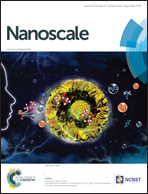Cyclodextrin-clicked silica/CdTe fluorescent nanoparticles for enantioselective recognition of amino acids†
Abstract
Fluorescent sensors based on semiconductor quantum dots (QDs) have been immensely investigated for achiral molecular recognition. For chiral discrimination of amino acids (AAs), we herein report a versatile fluorescent sensor, i.e., CdTe QDs encapsulated with cyclodextrin (CD) clicked silica via layer-by-layer modification. The as-obtained hybrid molecular recognition platform exhibited excellent chirality sensing of AAs at micromolar concentrations in water. By taking advantage of the inclusion complexation of CD and the optical properties of the QD core, chiral discrimination was realized on the basis of the different binding energies of the CD-AA enantiomer complexes, as revealed using density-functional theory calculation. The fluorescent probe exhibited linearly enhanced photoluminescence with increased concentration of D-histidine at 0–60 μM and L-histidine at 0–20 μM. These water-soluble fluorescent sensors using a chiral host with a covalently linked chromophore may find applications in the robust sensing of a wide range of achiral and chiral molecules in water.


 Please wait while we load your content...
Please wait while we load your content...